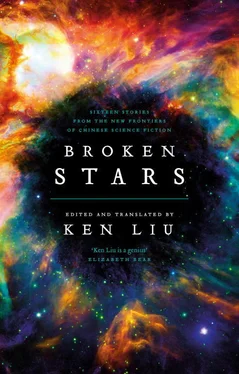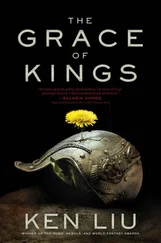You find it hard to describe your feelings with the choices offered on a psychology questionnaire: “never,” “occasionally,” “often,” “acceptable,” “average,” “unacceptable.”… Your feelings often spilled out of the boundaries of these markers, or wavered between them. That may be also why you cannot trust your therapist. You’re always paying attention to his gestures and expressions, analyzing his verbal habits and tics. You find that he has a habit of speaking in first-person plural: “How are we doing?” “Why do we feel this way?” “Does this bother us?” It’s a way to suggest intimacy and distance at the same time. Gradually, you figure out that by “we,” he simply means you.
You’ve never met the therapist in person; in fact, you don’t even know which city he lives in. The background projected on iWall is always the same room. When it’s dark where you are, his place is filled with bright daylight. Always the same. You’ve tried to guess what his life outside of work is like. Maybe he feels as helpless as you, and he doesn’t even know where to go for help. Perhaps that is why he’s always saying “we.” We are trapped in the same predicament.
You think you’re less like a living person but more like a machine, laid out on a workbench to be examined. The examiner is another machine, and you suspect that it needs to be examined more than you. Perhaps one machine cannot fix another.
You’ve bought some psychology books, but you don’t believe that their theories can help you. You believe that the root of the problem is that each of us lives on a thin, smooth layer of illusions. These illusions are made up from “common sense,” from repetitive daily linguistic acts and clichés, from imitating each other. On this iridescent film, we perform ourselves. Beneath the illusions are deep, bottomless seams, and only by forgetting their existence can we stride forward. When you gaze into the abyss, the abyss also gazes into you. You tremble, as though standing over a thin layer of ice. You feel your own weight, as well as the weight of the shadow under you.
You’ve been feeling worse recently, perhaps the result of the long winter, and your unfinished dissertation, graduation, and having to look for a job. You wake up in the middle of the night, turn on all the lights in the apartment, drag yourself out of bed to mop the floor, throw all the books from the shelf onto the floor just to look for one specific volume. You give up cleaning, letting the mess multiply and grow. You don’t have the energy to leave your home to socialize, and you don’t answer your emails. You dream anxious dreams in which you repeatedly visit the moments of failure in your life: being late for a test; turning over the test and not recognizing any of the characters you read; suffering for some misunderstanding but unable to defend yourself.
You wake up exhausted, fragmentary memories that should be forgotten resurfacing in your mind, assembling into a chaotic montage of an insignificant, failed, loser self. You know in your heart that the image isn’t true, but you can’t turn your gaze away. You suffer stomach cramps; you cry as you read and take notes; you turn the music as loud as it will go and revise a single footnote in your dissertation again and again. You force yourself to exercise, leaving your apartment after ten at night to go jogging so that no one will see you. But you don’t like to run; as you force your legs to move, one after the other, you ask yourself why the road is endless and what good will it do even if you finish.
Your therapist tells you that you should treat this self that you despise as a child, and learn how to accept her, to live with her, to love her. When you hear this, the image of that caped rabbit emerges in your mind: one ear longer than the other, drooping with sorrow. Your therapist tells you: Just try it. Try to hold her hand; try to lead her over the abyss; try to push away your suspicions and rebuild trust. This is a long and difficult process. A human being isn’t a machine, and there’s no switch to flip to go from “doubt” to “trust”; “unhappy” to “happy”; “loathe” to “love.”
You must teach her to trust you, which is the same as trusting yourself.
In a paper presented at an international artificial intelligence conference in Beijing in 2013, [2] Levesque, Hector J. “On our best behaviour.” Artificial Intelligence 212 (2014): 27–35.
computer scientist Hector Levesque of the University of Toronto critiqued the state of artificial intelligence research centered on the Turing test.
Levesque essentially argues that the Turing test is meaningless because it relies too heavily on deception. For example, in order to win the annual Loebner Competition, a restricted form of the Turing test, “the ‘chatterbots’ (as the computer entrants in the competition are called) rely heavily on wordplay, jokes, quotations, asides, emotional outbursts, points of order, and so on. Everything, it would appear, except clear and direct answers to questions!” Even the supercomputer Watson, who won Jeopardy! , was but an idiot savant who was “hopeless” outside its area of expertise. Watson could easily answer questions whose answers could be found on the web, such as “Where is the world’s seventh-tallest mountain?” But if you ask it a simple but unsearched-for question like “Can an alligator run the hundred-meter hurdles?” Watson can only present you with a set of search results related to alligators or the hundred-meter hurdles event. [3] This example comes from Marcus, Gary. “Why Can’t My Computer Understand Me?” The New Yorker , August 14, 2013 (accessible at http://www.newyorker.com/tech/elements/why-cant-my-computer-understand-me ).
In order to clarify the meaning and direction of artificial intelligence research, Levesque and his collaborators proposed a new alternative to the Turing test, which they call the “Winograd Schema Challenge.” [4] See, e.g., Levesque, H. J.; Davis, E.; and Morgenstern, L. 2012. The Winograd Schema Challenge. In Proceedings of KR 2012 . Levesque, H. J. 2011. The Winograd Schema Challenge. In Logical Formalizations of Commonsense Reasoning, 2011 AAAI Spring Symposium, TR SS-11-06 .
The inspiration for the challenge came from Terry Winograd, a pioneer in the field of artificial intelligence from Stanford. In the early 1970s, Winograd asked whether it would be possible to design a machine to answer questions like these: [5] The example is drawn from Terry Winograd, Understanding Natural Language (1972).
The city councilmen refused the demonstrators a permit because they feared violence. Who feared violence? [councilmen/demonstrators]
The city councilmen refused the demonstrators a permit because they advocated violence. Who advocated violence? [councilmen/demonstrators]
Despite the structural similarity of the two sentences, the answers to the two questions are different. Resolving the correct antecedent of the pronoun “they” requires more than grammars or encyclopedias; it also requires contextual knowledge about the world. Understanding anaphora is so easy for human beings that it barely requires thought, yet it presents a great challenge for machines.
Kate said “thank you” to Anna because her warm hug made her feel much better. Who felt better? [Kate/Anna]
How can a machine understand under what circumstances one person would thank another? How can a machine know what behaviors would make a person “feel much better”? These questions go to the fundamental nature of human language and social interactions. We have not done nearly enough research into these complexities hidden within simple-seeming sentences.
Читать дальше












